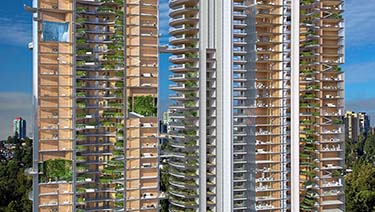|
Subscribe / Renew |
|
|
Contact Us |
|
| ► Subscribe to our Free Weekly Newsletter | |
| home | Welcome, sign in or click here to subscribe. | login |
Architecture & Engineering
| |
 |
March 4, 2021
The future of resilient commercial real estate
Special to the Journal

Demers
|

Greany
|
The fate of our downtowns is firmly in the spotlight lately. The optimists believe they will bounce back, the pessimists have already pronounced them dead and are eyeing island real estate. Most questions revolve around imagining a new “normal.” Will employees go back to the office, will working from home become the norm, how much office space will we need, what about hotels, events, conventions?
While we cannot be certain about the square footage, we can be confident that life will return. Human beings are resilient; they will continue to work, learn, live, dine out and seek entertainment. Our downtowns have a future.
However, it would be irresponsible to assume we know what the future looks like. What the pandemic has both disguised and accelerated are the inevitable changes that were already reshaping life as we know it. Digitization, globalization, automation, and AI are all untethering us from our familiar locales and destinations and creating new pathways and opportunities across the world.
The past is no longer predictive of the future. That’s why a group of like-minded architects, builders and engineers that includes B+H Architects, Mortenson, Coffman Engineers and Robert Bird Group is designing a resilient tower typology for the future. This new generation of buildings will be truly use and program neutral — easily modified for multiple uses.
B+H architect Matthias Olt describes the design concept, which is defined by a ring shape as being inspired by “organic structures like bamboo — a ring or tube is the most material-efficient and structurally effective building form. Equally relevant, every space module, window, and duct on this ring configuration can be identical, rotated, and replicated.”
The tower is inspired by five key characteristics that will allow it to adapt and evolve over time:
1. Health & wellness
Tech companies and others who compete fiercely for the best talent in the world are realizing that workplace wellness is one of the most important decision points for many employees, pushing companies to create mandates about net zero footprints, carbon neutrality and prioritizing spaces that enhance employee well-being and contribute to corporate environmental performance goals. Mass timber, a replenishable product offers many of these benefits, the challenge has been how does it scale and how does it become more resilient?
2. Financial sustainability
Single-use buildings are vulnerable to major economic shifts or world catastrophes. A building that is designed to quickly and easily reposition to accommodate new, diverse uses is inherently more valuable than those designed for a singular use. Working together, the team developed a proprietary method that creates towers that can be delivered faster, are more environmentally friendly, and can be “use and program” neutral — easily modified from office product to senior housing, to mixed-use, residential, hospitality or a mix of each — according to need.
3. Hybridization
How is this possible? By thinking literally outside the commercial box and pushing back on the limitations of yesterday’s product. Our team realized that the operations and functionality of a building are mainly driven by the elevator core and its large floor area — office towers need several elevators, residential towers need fewer, hotels may need public elevators for amenity space and private elevators for hotel rooms, etc. If you’ve ever watched a building being built, it is almost always the elevator cores that are built first, because they generally dictate the rest of the design. We realized that by moving the elevator core out of the main building, we could create a neutral use tower.
4. Componentization & prefabrication
The tower is made of highly componentized and prefabricated ring formations comprised of a hybrid and integrated mix of mass timber, concrete and steel, which is then stacked and assembled on site. By integrating mass timber with concrete slabs and steel, we are able to scale the buildings to any size. Smaller buildings can be made of all mass timber. Assembling the components on site versus traditional construction techniques minimizes disruption to the neighborhood, delivers a higher quality product that is made in a controlled environment and most importantly increases speed to market. Its flexibility makes it attractive to financial markets, REITS, Investors, users, etc.
5. Biophilia
The elevator core is assembled alongside the tower and is as tall as the building, efficiently serving one or multiple towers. The elevator core and the towers offer an outside garden for every floor, access to air, nature, and outdoor space — a biophilic approach to architecture that seeks to connect building occupants more closely to nature by incorporating elements like natural lighting and ventilation, natural landscape features, wood and other components to create a more productive and healthy built environment for people to work and live in. The rings also offer efficient surface areas, the curving aspect efficiently manages the heat load, and the interior atrium provides air flow to each floor. In addition, curved buildings have been strongly linked to a reduction in human stress levels.
Proof of concept
Our team is engaged with several investors and developers locally and internationally in testing multiple sites for specific building types and uses. Each team member — B+H Architects, Mortenson, Coffman Engineers and Robert Bird Group — brings critical expertise to these projects which call for a high degree of collaboration throughout preplanning, shop fabrication, cost estimating, analysis of environmental factors (such as wind, seismic and code requirements). This new product blurs boundaries and demands a similarly interactive, non-linear approach from its design team. We could not be more excited to be leaders in the next revolution of neutral tower design. We’re so inspired to be revolutionizing urban real estate design and creating a sense of confidence and stability in times of exponential change.
Doug Demers is managing principal, Seattle, at B+H Architects. Phil Greany is director of business development at Mortenson.
Other Stories:
- How to keep the creative spark in a virtual world
- The role of ventilation and healthy air
- It’s the end of the grocery store (as we know it)
- Are American shopping malls boxed-in?
- Influencing human scale, creating a sense of place
- Here are the 3 principles of renovation
- Not all feasibility studies are created equal
- Green Lake Community Center aims for inclusivity
- What if you can’t dig your way out of a brownfield cleanup?
- How A/E firms can increase proposal success in 2021
- Workplace wellness through technology
- 4 Living Buildings: collaborative, courageous, open-minded learning
- Foundations for healthy and sustainable urban places
- Parking garages: rethinking your front door
- A changed workforce and the implications for workplaces and cities



